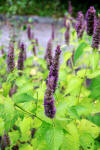WILD
FOODIES' HOME PAGE
PLANT PROFILE LIST
NAME: Anise Hyssop
SPECIES / FAMILY: Agastache Foeniculum / Lamiaceae
OTHER COMMON NAME(S): blue giant hyssop, lavender giant hyssop
CONDITIONS:
|
PARTS: |
EDIBLE |
TASTE |
RAW/COOK |
SEASON |
|
All |
|
|
|
|
|
Shoots |
|
|
|
|
|
Leaves |
|
licorice |
RAW/COOK |
summer |
|
Stalk/Stem |
|
|
|
|
|
Buds |
||||
|
Flowers |
|
licorice |
RAW/COOK |
summer |
|
Fruits |
|
|
|
|
|
Pods |
|
|||
|
Seeds |
|
|
|
|
|
Nuts |
|
|
|
|
|
Roots |
|
|
|
|
|
Bark |
|
|
|
|
PORTION: small
COMMENT: Leaves and flowers - used as a flavouring in raw salads or cooked dishes…can also be used to flavour cooked foods, especially acid fruits. The only drawback to the leaves is that they tend to have a drying effect in the mouth and so cannot be eaten in quantity. A pleasant tasting tea is made from the leaves.(1)
CAUTION: Always go slow with any plant in case you are allergic or sensitive to it. // Excessive mint exposure may cause an arthritic condition.
NUTRITION/MEDICINAL: Cardiac; Diaphoretic; Pectoral; Poultice. The leaves are cardiac and diaphoretic. An infusion of the leaves is used in the treatment of colds, fevers, weak heart etc. When left to go cold, the infusion is used to treat pains in the chest (such as when the lungs are sore from too much coughing). A poultice of leaves and stems can be used to treat burns.(1)
LOOK-A-LIKES: Other upright/plant, versus ground cover mints, such as spearmints - https://www.pfaf.org/user/Plant.aspx?LatinName=Mentha+spicata
POISONOUS LOOK-A-LIKES:
OTHER USES: Any mint is an insect and rodent repellent, just put some in a blender with water, sieve out fiber, use mint water to damp mop and dust. Also use to rinse woolen clothes to keep moths away.
SOURCE LINKS (may include nutritional and medicinal info, plus other uses):
- https://pfaf.org/User/plant.aspx?LatinName=Agastache+foeniculum
- https://en.wikipedia.org/wiki/Agastache_foeniculum
- https://sowtrueseed.com/blogs/gardening/anise-hyssop-an-easy-edible-perennial
